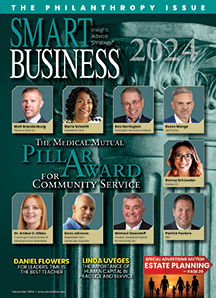When most people hear the phrase “The Big Three,” they think Ford, General Motors and Chrysler (now DaimlerChrysler).
But not Michael Merriman. The president and chief executive of Glenwillow-based Royal Appliance Manufacturing Co. thinks of that other Big Three: Royal, Hoover and Eureka.
That’s why, when he took over at Royal in 1995, he went to work turning Royal into the Chrysler of floor care products.
“Chrysler was kind of the youngest company, not as established as Ford and GM, and that was us,” Merriman says. “We were the least vertically integrated; we were not making our own motors or plastic power cords. We were doing final assembly, similar to what Chrysler was doing. GM had Delco and a real vertical, captive supply chain, whereas Chrysler was doing final assembly and went on to do the minivan and some really cool products at a rapid rate.
“GM was changing its chassis maybe every five years. Chrysler was on a much more aggressive development path.”
Merriman knew Royal needed to boost its new product development. Up to that point, the company had usually released only one new product a year.
“The theory was, let’s try to be the best at this new product development,” says Merriman, who was named a Visionary in the 2001 Innovation in Business awards. “We actually not only leveraged our skills in those areas, but we developed a real expertise in launching new products.”
Around that time, Merriman was talking with sales representatives from General Electric Plastics division, which supplied Royal with resins for its Dirt Devil vacuum cleaner. He told them Royal had a new corporate focus, but that its product development process needed to be improved to get products out faster and cheaper.
Executives at GE invited Royal’s core development team from marketing, engineering, sales, manufacturing, quality control and finance to GE’s Appliance Park in Louisville, Ky., to learn about its five-phase new product development process, which includes conceptual design, prototyping, engineering design, hard tooling and, finally, production. Merriman then geared the system for Royal’s use.
“The heart of it is to have a cross-functional team that meets weekly and manages the project chart,” Merriman says. “Everyone knows who’s doing what and how everyone is progressing on all the aspects of the chart and what tasks need to be done in this five-phase approach.”
GE’s new product development process paid off for Royal. Revenue, which had been slipping in former CEO John Balch’s final years, rose from $270 million in 1995 to $408 million in 2000.
Merriman ramped up new product development to three or more products a year, and changed Royal’s product launch strategy, most noticeably in new product advertising.
Balch had been a successful spokesman, advertising Dirt Devil vacuums with his golden retriever, Sam. With Balch out of the picture, Merriman started using two-minute direct response commercials, selling the new product directly to the consumer via phone orders, before the product hit major chains such as Kmart, Wal-Mart and Target.
Merriman educates consumers with the two-minute spots in major targeted markets; those are then replaced with one-minute ads. Once the product arrives on the shelves, the campaign is switched to 30-second ads shown nationwide.
Since 1996, revenue from telephone orders has paid for more than half of direct response advertising costs.
“We couldn’t afford to spend lots of money on advertising in terms of 30-minute infomercials,” Merriman says. “The intent was, we wanted to sell intuitive products that people say ‘Wow’ to.
“It shouldn’t take more than a minute to explain, and a minute to give them the hard-sell pitch to go buy it.”
How to reach: Royal Appliance, (440) 996-2000

